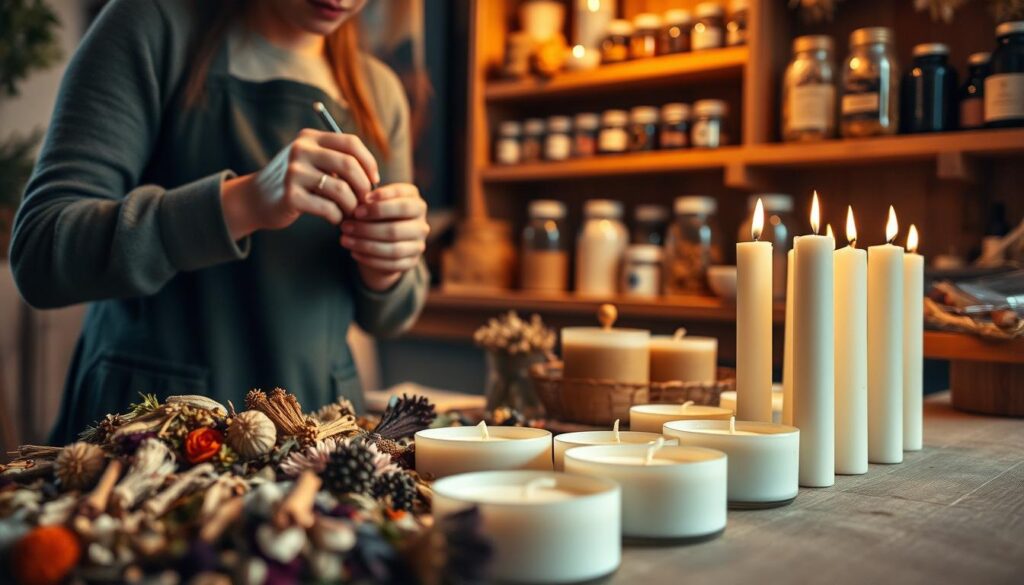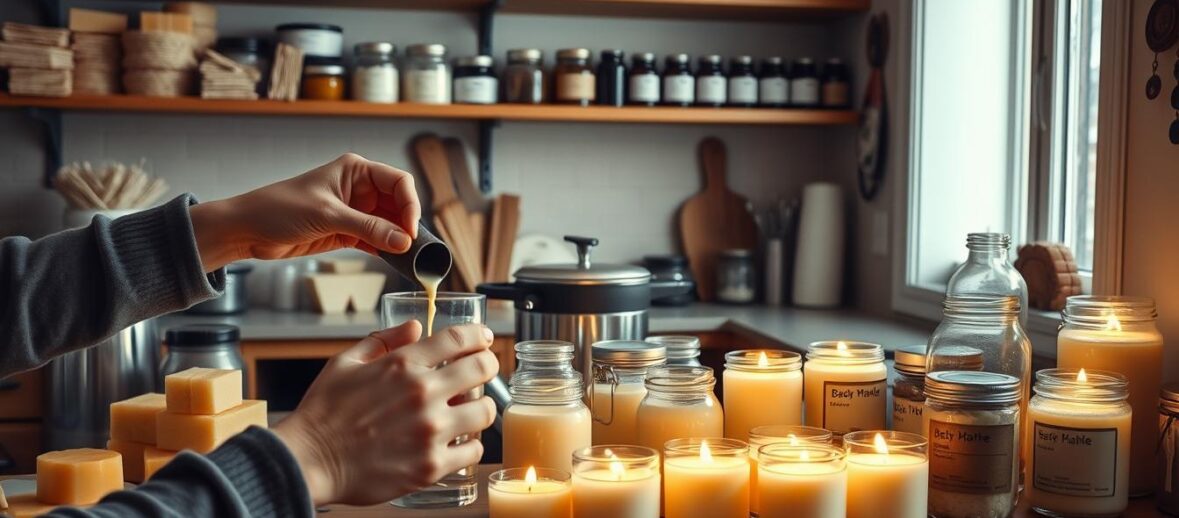Ever thought about making your living space special with a personal touch? Homemade candle making lets you create candles that show off your style and personality. These candles can fill your room with warmth and lovely scents.
Starting out in candle making might seem scary. But, it’s actually quite easy! Whether you want to make gifts or set a cozy mood at home, making candles is a great way to express your creativity.
In this guide, we’ll show you how to make beautiful candles from scratch. You’ll learn how to turn simple things into magical candles that light up any room and warm hearts.
Key Takeaways
- Discover the joy of creating personalized candles
- Learn fundamental candle making techniques
- Understand essential tools and materials
- Explore creative scenting and coloring options
- Master safety protocols for successful candle crafting
Getting Started with Candle Making Basics
Starting your candle making journey is exciting. You’ll learn the basics to make beautiful candles. Whether you’re a hobbyist or want to be a pro, knowing the basics is key.
Understanding Different Types of Wax
Choosing the right wax is important. For beginners, two types are great:
- Soy Wax: Eco-friendly and burns clean, perfect for diy soy candles
- Beeswax: Natural with a honey scent, great for beeswax candles diy
| Wax Type | Pros | Best For |
|---|---|---|
| Soy Wax | Renewable, low melting point | Scented candles, beginner projects |
| Beeswax | Natural air purifier, long burn time | Unscented, natural decor |
Essential Tools and Materials Needed
Having the right supplies makes crafting fun and easy:
- Double boiler or melting pot
- Digital thermometer
- Pouring pitcher
- Variety of wicks
- Containers or molds
“The right tools transform candle making from a challenge to a joy.” – Crafting Enthusiast
Safety Precautions and Workspace Setup
Working with hot wax needs a safe space. Pick a well-ventilated area, away from flammable stuff. Use disposable drop cloths and have a fire extinguisher ready.
Wear heat-resistant gloves and an apron for safety. This is important for your beeswax candles diy project.
Learn to Make a DIY Candle
Making scented candles is a fun craft that lets you create unique home fragrances. It’s great for both beginners and those who love making candles. This guide will show you how to make your own beautiful candles step by step.
Measuring and Melting the Wax
Being precise is important in candle making. First, measure your wax carefully with a digital scale. To melt the wax safely, use a double boiler. Here’s what to do:
- Choose the right wax for your project
- Measure wax precisely with a kitchen scale
- Use a double boiler to avoid direct heat
- Heat wax to 185°F before adding fragrance
Adding Fragrance and Color
When making essential oil candles, picking the right fragrance is key. Here’s how to pick the perfect scent:
| Fragrance Type | Recommended Load | Best Uses |
|---|---|---|
| Essential Oils | 6% of total wax weight | Natural, subtle scents |
| Fragrance Oils | 8-10% of total wax weight | Stronger, longer-lasting scents |
Pouring Techniques and Temperature Control
Proper pouring is key for smooth, professional candles. Temperature control is crucial for a great final product:
- Let wax cool to 135°F before pouring
- Pour slowly to avoid air bubbles
- Keep the wick centered while pouring
- Let candles cool completely at room temperature
Pro Tip: Patience is key in scented candle making. Take your time and enjoy the process!
Choosing the Right Containers and Wicks
Choosing the right containers and wicks is key in candle making. Your selection can greatly affect the candle’s look and how well it works.
When looking for candle making supplies, focus on containers and wicks. The right mix ensures a candle that looks great, lasts long, and burns well.
Container Selection Guide
Your container choice is very important in candle making. Here are some options:
- Glass jars (mason jars, vintage containers)
- Ceramic vessels
- Metal tins
- Heat-resistant ceramic containers
“The container is not just a vessel, it’s part of your candle’s character.” – Candle Making Artisan
Wick Sizing Essentials
Finding the right wick size for your container is an art. The size depends on two main things:
- Container diameter
- Type of wax used
A wick that’s too small won’t melt the wax fully. A wick that’s too big can burn unevenly or smoke too much. Precision is key in successful homemade candle making.
Pro tip: Always test your wick size with a small batch before making more candles.
Natural Scenting and Coloring Options
Making scented candles is more than just melting wax. You can add unique touches by using natural scents and colors. This makes your essential oil candles stand out.

Essential Oils vs Fragrance Oils
In scented candle making, you’ll find two main scents: essential oils and fragrance oils. Each has its own special qualities.
- Essential Oils:
- They come from natural plants
- Give off soft, real smells
- Don’t have as strong a scent as synthetic ones
- Fragrance Oils:
- They’re made from synthetic stuff
- Have a strong and lasting smell
- Offer a wide range of scents
Natural Colorants and Additives
Make your essential oil candles pop with natural colors. This adds beauty and personality.
| Natural Colorant | Color Produced | Recommended Usage |
|---|---|---|
| Turmeric | Yellow | 1-2 teaspoons per pound of wax |
| Beetroot Powder | Pink/Red | 1-3 teaspoons per pound of wax |
| Spirulina Powder | Green | 1-2 teaspoons per pound of wax |
Proper Measurements and Combinations
Getting the right mix in scented candle making is key. For essential oil candles, use 1 ounce of fragrance per pound of wax. Start small to try out different mixes and find your favorite.
Pro tip: Always test your scent and color combos in small amounts before making a big batch.
Troubleshooting Common Candle Making Issues
Starting with beginner candle crafting can be fun but also comes with challenges. DIY soy candles often face common problems that might upset new makers. Knowing how to spot and fix these issues will help you make stunning candles every time.
Let’s look at the most common candle making problems:
- Tunneling: This happens when your candle burns straight down the center, leaving wax around the edges.
- Frosting: A white, crystalline look on the candle’s surface that ruins its look.
- Uneven burns that make the candle shape irregular
- Weak scent throw that doesn’t spread in the room
To solve these issues in your diy soy candles, try these expert tips:
- To avoid tunneling, make sure the first burn melts the wax all the way to the top.
- Stop frosting by pouring wax at the right temperature (135-145°F).
- Pick the right wick size for your container for even burning.
- Use top-notch fragrance oils and follow exact measurement guidelines.
Beginner candle crafting needs patience and practice. Every candle you make is a chance to get better and learn about wax, temperature, and technique.
Pro tip: Keep a detailed journal of your candle-making process to track what works and what needs improvement.
Professional Tips for Perfect Candles
Improving your candle-making skills takes focus and a deep understanding of the craft. Whether you’re making beeswax candles DIY or trying other waxes, learning a few key techniques can make a big difference.
Creating top-notch candles is more than just following basic steps. Experts know that success comes from the small details of preparation, storage, and burning.
Curing Time and Storage Secrets
Patience is key in candle making. Your candles need time to cure for the best scent and performance:
- Let beeswax candles DIY cure for 24-48 hours before using
- Store candles in a cool, dry place, away from sunlight
- Use airtight containers to keep the fragrance in
Burning Guidelines for Maximum Enjoyment
Right burning techniques are essential for consistent candle performance:
- Burn candles for 2-4 hours each time
- Trim the wick to 1/4 inch before lighting
- Make sure the wax melts evenly
Quality Control Measures
“Perfection is in the details of candle crafting.” – Artisan Candle Maker
Professional candle makers do thorough quality checks. Test your candles by checking:
- Burn time consistency
- Scent throw strength
- Even wax melting
- Wick performance
By following these professional tips, you’ll make beeswax candles DIY that are as good as store-bought ones. They’ll add warmth and beauty to any room.
Conclusion
Homemade candle making is a fun craft that lets beginners unleash their creativity. You start by learning the basics and using your imagination. Each candle you make tells a story, showing off your unique style.
As a beginner, you’ve picked up key skills to make beautiful candles. These skills will grow as you practice. You can try out different waxes, scents, and designs. Remember, every candle maker starts as a beginner, eager to learn.
Safety and patience are key in this craft. Take your time to learn each step and practice. Don’t worry about making mistakes. They teach you important lessons about temperature, scent, and wick selection.
Keep exploring candle making by joining local craft groups, watching videos, and reading guides. Your creative journey is just starting, and the possibilities are endless.

